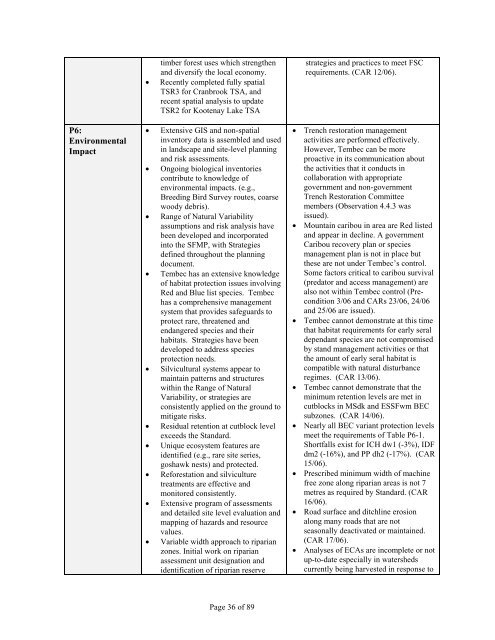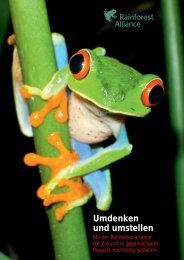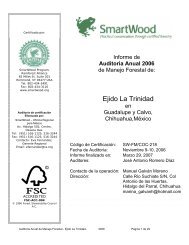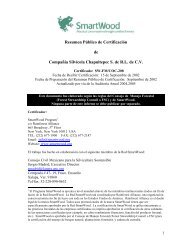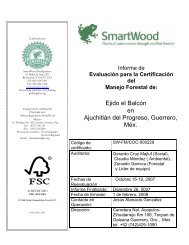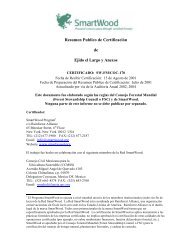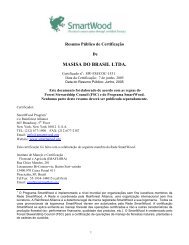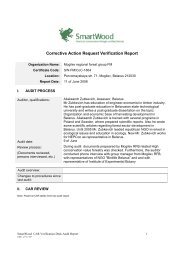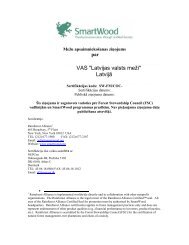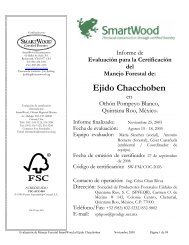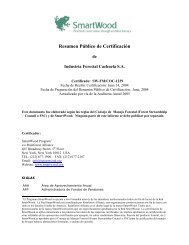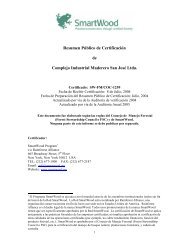Forest Management Certification Assessment Report for - Rainforest ...
Forest Management Certification Assessment Report for - Rainforest ...
Forest Management Certification Assessment Report for - Rainforest ...
You also want an ePaper? Increase the reach of your titles
YUMPU automatically turns print PDFs into web optimized ePapers that Google loves.
P6:EnvironmentalImpacttimber <strong>for</strong>est uses which strengthenand diversify the local economy.• Recently completed fully spatialTSR3 <strong>for</strong> Cranbrook TSA, andrecent spatial analysis to updateTSR2 <strong>for</strong> Kootenay Lake TSA• Extensive GIS and non-spatialinventory data is assembled and usedin landscape and site-level planningand risk assessments.• Ongoing biological inventoriescontribute to knowledge ofenvironmental impacts. (e.g.,Breeding Bird Survey routes, coarsewoody debris).• Range of Natural Variabilityassumptions and risk analysis havebeen developed and incorporatedinto the SFMP, with Strategiesdefined throughout the planningdocument.• Tembec has an extensive knowledgeof habitat protection issues involvingRed and Blue list species. Tembechas a comprehensive managementsystem that provides safeguards toprotect rare, threatened andendangered species and theirhabitats. Strategies have beendeveloped to address speciesprotection needs.• Silvicultural systems appear tomaintain patterns and structureswithin the Range of NaturalVariability, or strategies areconsistently applied on the ground tomitigate risks.• Residual retention at cutblock levelexceeds the Standard.• Unique ecosystem features areidentified (e.g., rare site series,goshawk nests) and protected.• Re<strong>for</strong>estation and silviculturetreatments are effective andmonitored consistently.• Extensive program of assessmentsand detailed site level evaluation andmapping of hazards and resourcevalues.• Variable width approach to riparianzones. Initial work on riparianassessment unit designation andidentification of riparian reservestrategies and practices to meet FSCrequirements. (CAR 12/06).• Trench restoration managementactivities are per<strong>for</strong>med effectively.However, Tembec can be moreproactive in its communication aboutthe activities that it conducts incollaboration with appropriategovernment and non-governmentTrench Restoration Committeemembers (Observation 4.4.3 wasissued).• Mountain caribou in area are Red listedand appear in decline. A governmentCaribou recovery plan or speciesmanagement plan is not in place butthese are not under Tembec’s control.Some factors critical to caribou survival(predator and access management) arealso not within Tembec control (Precondition3/06 and CARs 23/06, 24/06and 25/06 are issued).• Tembec cannot demonstrate at this timethat habitat requirements <strong>for</strong> early seraldependant species are not compromisedby stand management activities or thatthe amount of early seral habitat iscompatible with natural disturbanceregimes. (CAR 13/06).• Tembec cannot demonstrate that theminimum retention levels are met incutblocks in MSdk and ESSFwm BECsubzones. (CAR 14/06).• Nearly all BEC variant protection levelsmeet the requirements of Table P6-1.Shortfalls exist <strong>for</strong> ICH dw1 (-3%), IDFdm2 (-16%), and PP dh2 (-17%). (CAR15/06).• Prescribed minimum width of machinefree zone along riparian areas is not 7metres as required by Standard. (CAR16/06).• Road surface and ditchline erosionalong many roads that are notseasonally deactivated or maintained.(CAR 17/06).• Analyses of ECAs are incomplete or notup-to-date especially in watershedscurrently being harvested in response toPage 36 of 89


